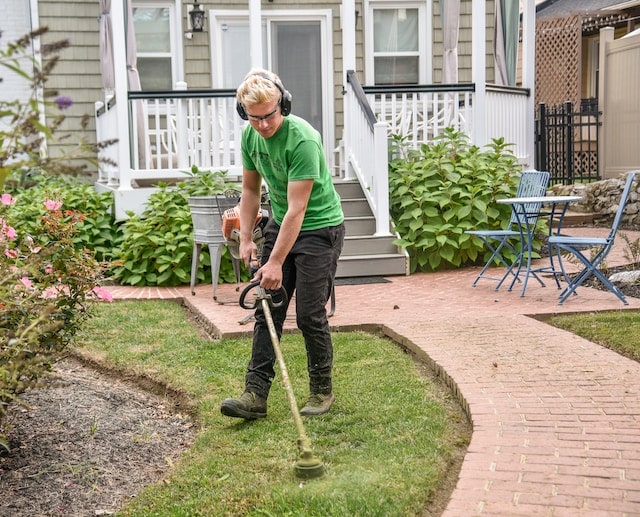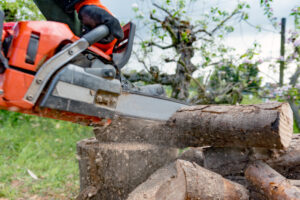Keeping up with the upkeep of the landscape grading is an essential part of taking care of your outside space. The slope and contour of the ground in your backyard are referred to as its grading, and it is a vital component for effective drainage and water management.
It is important to have your property properly graded so that water does not pool around the base of your house, as this can lead to structural problems as well as flooding. Additionally, it helps prevent erosion, which is a contributing factor in the loss of soil as well as other difficulties.
What Does Grading a Yard Mean?
The process of grading a yard involves creating a gentle slope as part of the yard levelling process. In other words, it is the act of adjusting the slope of your yard so that precipitation of any kind, including rainwater and snow, flows away from the base of your house. The slope of your lawn around your house should ideally be 5 per cent. This indicates that the ground level approximately ten feet away from your house will be approximately six inches lower than the ground level just close to your home's foundation.
On the other hand, grades falling anywhere between 3% and 25% are typically judged to be satisfactory. Your yard may require regarding if the grade that it already has is less than that or if the grade that it currently has does not direct runoff away from your house. Erosion can be caused by a slope that is greater than 25 per cent and typically necessitates a different operation known as landscape grading.
Why do I need to grade my landscape?
Because single-family homes account for around 67% of all landscaping jobs carried out in Australia, you will likely have to grade your garden at some point. Because of this, grading can also be used to ensure that water runs away from your house and won't erode your land. This can be accomplished by ensuring good drainage. Additionally, it can prevent water from standing, which, in addition to preserving your green space, can protect your family from mosquito activity by preventing water from standing. Through the process of grading, a gentle slope will be added to particular portions of your land to ensure that water flows as it should and that your property as a whole looks more appealing.

How do I go about doing this landscaping project?
There are some property owners who desire to grade their own land, but doing an inadequate job of grading can be just as detrimental as not doing any grading at all. Because there is an actual science behind grading, it is recommended that you have it done by a qualified professional rather than attempting to do it yourself. First, your landscaper will be able to determine whether or not the ground is uneven and whether or not drainage is an issue on your property.
After that, they will scrape away the topsoil in order to sculpt the ground beneath it. The topsoil will be reapplied when the grass or plants have begun to establish a root system and any necessary irrigation lines have been installed. After that, your landscaper will make sure that everything is level and smooth things out for you.
Even though landscape grading is a vital initial stage in the process, it is easy to forget about it amid all the enthusiasm that comes with revamping your outdoor space. However, if you take the time to ensure that it is done properly from the beginning, not only will you be able to carry out your plans without a hitch, but you also won't have to worry about water drainage problems in the future.
How to Apply Landscaping Grading?
The process of shaping and sloping the ground in order to produce an outdoor space that is both functional and visually pleasing is referred to as landscape grading. When implementing landscape grading, the following steps are fundamental steps to follow:
- Evaluate Your Landscape. It is essential to conduct a thorough analysis of the pre-existing circumstances before you start grading your landscape. Look for regions where water is collecting into pools, where there is severe erosion, or where there are other drainage problems. If you can identify these challenges, you will have a better chance of developing an effective grading strategy that takes these issues into account.
- Determine the Desired Grade. After conducting an assessment of your landscape, you will be able to choose the appropriate level. This will be determined by the function of the area, as well as any drainage or water management requirements that may exist. When grading a grass area, for instance, you should create a little incline away from the base of your house to discourage the collection of rainwater there. This will help keep your basement dry. You may choose a flat surface that is level and even if you are grading a patio area.
- Create a Grading Plan. Create a grading plan that, using the information you received during your evaluation, specifies the essential modifications that need to be made in order to attain the desired grade. Your plan needs to contain specifics like the slope and contour of the land, the position of drainage systems, and any retaining walls or other buildings that are required.
- Prepare the Site. You will need to get the location ready in advance of beginning the grading. This may involve clearing the area of any existing plants or debris, identifying the area that will be graded, and making sure that any licences and approvals that are required are in place.
- Begin Grading. After you have finished preparing the site, you can move on to grading the landscape. For this purpose, heavy types of machinery such as bulldozers and excavators may be utilised in order to move soil about and sculpt the terrain. While you are grading the landscape, it is important to examine the slope and contour of the ground on a frequent basis to verify that you are reaching the grade that you want.
- Install Drainage Features. In order to manage water and minimise pooling or erosion, drainage features such as French drains, swales, and catch basins should be installed, if necessary.
- Finish the Surface. After you have completed the installation of any necessary drainage systems and have achieved the desired slope, you may finish the surface by adding topsoil and any other materials that are required. To further boost the space's aesthetic appeal, consider including elements of landscaping into its design, such as plants, beautiful stones, or mulch.
How do you calculate landscape grading?
In order to calculate landscape grading, one must first determine the slope or grade that should be applied to the ground and then measure the present elevation of the area that is going to be graded. The following are the fundamental steps involved in calculating the grade of a landscape:
- Decide the intended slope or grade for the area that needs to be graded before moving on to the next phase in the process of calculating landscape grading, which is to establish the ideal slope or grade for the area. The answer to this question will be determined by the anticipated usage of the area as well as the requirements for water management.
- Once you have chosen the appropriate grade, the next step is to measure the existing elevation of the area that will be graded. This can be done by standing in the area that will be graded. This can be accomplished with the use of a laser level, a surveyor's level, or any number of other instruments.
- Determine the slope: The next step is to determine the slope that is required to attain the desired grade, and this is done by calculating the slope. To accomplish this, take into account the distance between the present elevation and the desired elevation, then subtract the existing elevation from the desired elevation.
If, for instance, the planned elevation is 10 feet and the present elevation is 6 feet, and the distance between the two points is 30 feet, then the slope would be (10-6/30 = 0.13 or 13%); the distance between the two points would also be 30 feet.
4. After you have determined the slope, you can determine the amount of material that will be required to reach the target grade. This can be done by dividing the slope by the desired grade. This will be determined by the size of the area that needs to be graded as well as the needed level of grading depth.
5. Incorporate drainage: When determining the grading of a landscape, it is essential to take into consideration drainage, in addition to slope and grade. Erosion, standing water, and other water-related problems can be avoided by ensuring that there is enough drainage.
You will be able to ensure that the grading of your landscape is done precisely and successfully if you follow these steps and collaborate with a qualified professional landscaper or grading contractor.
Tips for maintaining the grading in your landscape
Regularly Inspect Your Landscape
If you evaluate your landscape on a regular basis, you can catch any grading problems in their earliest stages. Check for regions where water is collecting, as well as places where there is significant erosion or movement of the soil.
If you catch these problems in their earliest stages, you can avoid causing more serious damage and save time and money on repairs.
Address Drainage Problems
Issues with drainage can result in considerable damage to both your home and your landscaping. It is possible that there is an issue with the drainage in your yard if you find that water pools around the foundation of your home or in other places in your yard.
Drainage issues can be remedied in a number of ways, including the installation of a drainage system, alterations to the landscape, and the use of various water management strategies.
Maintain Your Gutters and Downspouts
It is possible to prevent water from accumulating around the foundation of your home and causing damage by ensuring that the gutters and downspouts are in good working order.
It would be best if you made it a habit to clear up your gutters on a regular basis and check that the water from your downspouts is flowing away from your house.
Repair Erosion and Soil Movement
Both erosion and soil movement can result in serious damage to your home and its surrounding surroundings. It is imperative that you take fast action to resolve the issue as soon as you become aware of any areas where the soil is excessively moving or where there is erosion.
You can restore damage caused by erosion and movement of soil by regrading the landscape, putting in place erosion control measures, or making use of other ways for stabilising the soil.
Hire a Professional
If you are trying to figure out how to manage the grading in your landscape or if you are suffering serious drainage or erosion issues, it is likely in your best interest to contact a professional to assist you with these concerns.
Your landscape can be evaluated by a landscape contractor or another qualified specialist, who can then make recommendations regarding the best way to ensure that the right grading and water management are maintained.
Can I Grade My Own Landscape?
Although it is possible for homeowners to try levelling the terrain on their own by renting a bulldozer, we do not encourage this course of action. It is important that the grading of your land be done correctly, as any damage to the house or property that results from improper grading can be quite costly to restore. Local regulations may not only require licences for excavating, but they may also require them for locating and avoiding utility lines such as water, gas, electric, and fibre optic cables. Selecting the most effective drainage systems and correctly installing them is work that is best delegated to a professional, as is ensuring that the sloping achieves the desired results.
Advantages and Disadvantages of Landscape Grading Maintenance
Advantages:
- Increases Water Management: Landscaping that is graded correctly helps to improve water management, which in turn reduces the likelihood that your home's foundation or other buildings may be damaged. In addition to this, it stops runoff and soil erosion, both of which are harmful to the environment.
You may save yourself a lot of money on costly repairs by diverting water away from the foundation of your home and other spots where it may pool up.
In addition, you may safeguard your landscape, preserve the fertility of the soil, and stop the contamination of streams if you stop runoff and soil erosion from happening by using preventative measures.
- Boosts Aesthetic Appeal: By sculpting and sloping the ground, landscape grading can make an outdoor place look more appealing. This is accomplished by modifying the landscape. It is possible to construct planting beds, add contour and character to the landscape, and level an area that will be used for a patio or other outdoor living space with the help of good grading.
This may make your property more beautiful, it can raise the charm of your front yard, and it can make your outdoor space more welcoming. You and your loved ones may find that taking pride in and enjoying a landscape that has been thoughtfully designed, constructed, and cared for brings you both satisfaction and pleasure.
- The value of your property can be increased by having a landscape that is properly graded and maintained on a regular basis. When you go to sell your house, having a landscape that has been thoughtfully created may be a key selling point. This is especially true in regions where people enjoy spending time outside.
You may add to the value of your property and make it more appealing to prospective buyers if you improve the aesthetic appeal, practicality, and durability of the outside space you have.
- Landscape grading can also help prevent safety issues by ensuring that the ground is level, stable, and safe for walking, playing, and other activities. This ensures that people can safely engage in activities such as these.
For instance, a surface that is flat and even can lessen the chance of tripping and falling, which is especially important in locations where children play. In addition, you should avoid standing water by ensuring that there is adequate drainage in the area. Standing water is known to be a breeding ground for mosquitoes and other insects that can represent a risk to human health.

Disadvantages:
- Cost: The process of landscape grading can be an expensive one, especially if considerable alterations are required to attain the appropriate slope in the landscape. The cost of grading can vary depending on a number of different aspects, such as the size of the area being graded, the kind of equipment that is utilised, and the quantity of material that is required.
In addition, you will be required to pay for the services of a professional landscaper if you hire one to grade your outside space for you. Yet, although the initial investment could be substantial, correct grading can help save expensive repairs and maintenance in the future.
- Disruption: Landscape grading has the potential to be a source of interruption to both your property and your normal routine. It may be necessary to clear the area of vegetation, add drainage features, or make other alterations that are disruptive and time-consuming.
Also, the utilisation of heavy machinery for the purpose of grading might result in the production of noise and vibration, both of which may annoy your neighbours. You may reduce the amount of disruption caused to both your property and your neighbours if you prepare beforehand and communicate effectively.
- Effect on the Environment: The process of landscape grading often involves the utilisation of various materials and heavy machinery, both of which can have an influence on the environment. This may involve the pollution of the air or the land, as well as any number of other environmentally damaging repercussions.
The negative effects of landscape grading on the surrounding ecosystem can, however, be lessened by careful design. The use of eco-friendly resources, such as compost and organic fertilisers, and the implementation of erosion control methods, such as growing native flora, are two examples of what you could do to help the environment.
- Upkeep: In order to ensure that the proper grading of the landscape continues to be effective, it is necessary to do regular upkeep. Maintenance may include doing routine inspections, repairs, or adjustments to drainage features or other infrastructure as needed.
In addition, the terrain may undergo settling or shifting over time, which may necessitate extra grading or other types of repairs. You can, however, ensure that the grading of your landscape remains effective and continues to bring enduring benefits by doing the necessary maintenance.
Explore Other Options
There are some yard grading chores that are more complex than this one. You won't have enough room to correctly grade the surface around your home if you have a yard that's either too tiny or has a unique shape. In the event that this is the case, you can move water away from low places in your yard by constructing an element known as a French drain that is buried underneath the earth. Nevertheless, if your yard has high slopes, a retaining wall can help prevent erosion while still allowing for adequate drainage. This option is especially useful in landscapes with steep slopes.
Summary
In conclusion, it is necessary to properly maintain the grading in your landscape if you want to ensure efficient drainage and water management. Inspecting your landscape on a regular basis, fixing any drainage issues, maintaining your gutters and downspouts, repairing any erosion or soil movement, and working with a professional when necessary are all things that can help to keep your landscape in good health and ensure that it continues to look beautiful.
Frequently Asked Questions
What are the signs of poor landscape grading?
There are several indicators that may suggest poor landscape grading. These include:
- Water pooling or standing in certain areas of the yard after rainfall.
- Uneven surfaces or depressions in the landscape.
- Soil erosion or visible gullies are forming.
- Water seeping into basements or crawlspaces.
- Plants or grass are dying or struggling to grow in certain areas.
- Puddles or runoff near the foundation of the house.
If you notice any of these signs, it's important to consider landscape grading maintenance to rectify the issues.
Why is landscape grading maintenance important?
Landscape grading maintenance is crucial for several reasons. Firstly, it helps with proper water drainage, preventing water from pooling around foundations or in low-lying areas, which can cause structural damage and create breeding grounds for pests. Secondly, it aids in preventing erosion, which can lead to soil loss and landscape deterioration. Additionally, it ensures a level surface for landscaping projects and enhances the overall aesthetics of the outdoor space.
Are permits required for landscape grading maintenance?
Permit requirements for landscape grading maintenance vary depending on local regulations, the extent of the work being performed, and the specific area where the property is located. In some cases, minor grading adjustments may not require a permit. However, for larger-scale projects or significant modifications to the landscape, it's advisable to check with the local building or planning department to determine if permits are necessary. Obtaining the required permits ensures compliance with local laws and helps prevent potential issues in the future.
Can landscape grading maintenance affect my property's drainage and foundation?
Yes, landscape grading maintenance can have a significant impact on the drainage and foundation of your property. Proper grading ensures that water flows away from the foundation, preventing water intrusion and potential damage. If the landscape grading is inadequate or slopes toward the foundation, it can lead to water pooling, basement flooding, or foundation issues. By maintaining proper landscape grading, you can help protect your property's drainage system and the structural integrity of your home.
Can landscape grading maintenance improve the aesthetics of my outdoor space?
Absolutely! Landscape grading maintenance not only addresses functional aspects like drainage and erosion control but also enhances the visual appeal of your outdoor space. By creating even surfaces and eliminating depressions or uneven terrain, landscape grading can provide a smoother canvas for landscaping features like gardens, lawns, patios, or walkways. It helps create a more visually pleasing and harmonious landscape while ensuring proper water flow and preventing potential issues.







